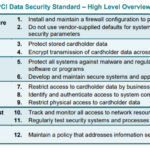As someone who operates within the realm of service provision, it’s crucial for you to understand the nuances of the Payment Card Industry Data Security Standard (PCI-DSS) validation process. This article is designed to provide a comprehensive overview, detailing exactly how the PCI-DSS validation process functions for service providers. Armed with this understanding, you’ll be better equipped to manage this crucial component of your business, significantly enhancing your capacities in data security and compliance.
Understanding PCI-DSS
Definition of PCI-DSS
PCI-DSS, or the Payment Card Industry Data Security Standard, is a set of security standards designed to ensure that all businesses that accept, store, process, or transmit credit card information uphold a secure environment. Introduced by the Payment Card Industry Security Standards Council, this mandatory regulation applies to all entities involved in payments from the major card schemes.
Importance of PCI-DSS in financial services
In the ever-evolving financial services landscape, compliance with PCI-DSS is crucial. It serves as a critical security standard that helps protect sensitive payment card information and mitigate the risk of data breaches. Financial institutions are required to manage vast amounts of cardholder data, making them an attractive target for hackers. By adhering to PCI-DSS, financial services can safeguard themselves against cyber threats and reduce the risk of substantial financial losses and reputation damage that stem from data breaches.
Roles of PCI-DSS in securing cardholder data
PCI-DSS plays a pivotal role in securing cardholder data. The standard consists of 12 requirements that cover six areas: maintaining a secure network, protecting cardholder data, managing vulnerabilities, implementing strong access control measures, monitoring and testing networks, and maintaining an information security policy. Each requirement is designed to prevent fraud and protect both the end customer and the financial institution.
The Importance of PCI-DSS Validation for Service Providers
Protecting customers’ data
Validation of compliance with PCI-DSS is an essential aspect of data security for service providers. It reaffirms the service provider’s promise to protect customers’ credit card information, bolstering their clients’ trust in their ability to securely conduct business. A breach of cardholder data could lead to substantial damage, including financial loss, reputational impact, and potential legal repercussions.
Ensuring legitimacy of services
For service providers, PCI-DSS validation is an indicator of their legitimacy and commitment to securing their clients’ information. It demonstrates that they follow the best practices outlined by the PCI Security Standards Council, and hence, are up to par with the industry’s most rigorous security requirements.
Fostering customer trust
In an era where data breeches are increasingly prevalent, trust is a valuable commodity. Compliance with PCI-DSS can help instill confidence in customers that their data is protected and treated with the utmost care, fostering stronger, more enduring relationships between service providers and their clients.
Who Requires PCI-DSS Validation?
Types of service providers needing validation
Any organization that directly handles customer payment card data requires PCI-DSS validation. This includes merchants, payment processors, data storage providers, and other service providers that can potentially access cardholder information.
The role of merchants in validation
Merchants can play a substantial role in the validation process by ensuring that their payment systems adhere to PCI-DSS requirements. By regularly reviewing and updating their systems, merchants can prevent potential vulnerabilities that could be exploited by cybercriminals.
Criteria for validation eligibility
While any entity that handles cardholder data is required to validate their PCI-DSS compliance annually, the exact procedures will vary based on the volume of transactions processed during a 12 month period. It is essential for organizations to understand their transaction volume to know what validation procedures they will be required to undertake.
Overview of the PCI-DSS Validation Process
Steps involved in the validation process
The validation process begins with determining the applicable validation level based on the volume of transactions. Following that, a comprehensive self-assessment questionnaire (SAQ) must be completed. Service providers may also be required to undergo a vulnerability scan with an approved vendor. Finally, an attestation of compliance must be filled out and submitted.
Role of the service provider in the process
The service provider’s role in the PCI-DSS validation process is to ensure that they meet each of the 12 PCI-DSS requirements. They must adhere to these requirements in their operations and business practices and document their compliance. The specifics and depth of the validation process may vary, dictated by the classification of the service provider.
Importance of self-assessment questionnaires in the process
Self-Assessment Questionnaires are a vital part of the PCI-DSS validation process. These questionnaires allow service providers to evaluate their compliance with the standard’s requirements. There are several versions of the SAQ to accommodate various scenarios, making them a flexible tool for overall data security.
Understanding PCI-DSS Validation Levels
Concept of validation levels
The PCI-DSS validation levels correspond to the volume of transactions that a company processes in a year. There are four levels in total, with Level 1 being the most rigorous and applicable to organizations that process over six million transactions annually.
Determining validation levels
Validation levels are determined by the number of transactions an organization handles over a year across all platforms. These levels play a crucial role in deciding the audit requirements and documentation an organization will need to submit for validation.
Importance and impact of each level
Understanding the different levels is key to understanding the scope and extent of a company’s validation process. Higher levels correspond to a greater transaction volume, indicating a larger potential for risk, and thus necessitating more stringent controls and audits.
Roles of Qualified Security Assessors(QSA)
Definition of a QSA
QSAs or Qualified Security Assessors are experts who are authorized by the PCI Security Standards Council to perform PCI-DSS audits. They have the necessary technical expertise and understanding of PCI-DSS standards to audit businesses for compliance.
Roles of a QSA in the validation process
In the validation process, a QSA’s responsibility is to conduct a full audit, examining all areas of a business’s operations to ensure they are compliant with PCI-DSS requirements. They help businesses understand the standard, support them in filling out the self-assessment questionnaire, and provide assurance that proper data security controls are in place.
Benefits of involving QSA in the process
Involving a QSA in the validation process offers several benefits. It ensures a thorough assessment has been conducted and validates that all compliance areas have been addressed. It also provides businesses with an independent view of their data security practices, thus highlighting areas that require improvement.
Reporting in PCI-DSS Validation
Importance of Report on Compliance (ROC)
A ROC is a document that details an organization’s compliance with PCI-DSS. Produced by a QSA after an audit, the ROC is a complete record that validates a company’s compliance. It’s an essential part of the validation process and offers a comprehensive view of an organization’s data security standing.
Understanding Attestation of Compliance (AOC)
The AOC serves as proof that a business has successfully completed the PCI-DSS validation process. Typically completed by a QSA, the AOC states that the company has either completed a successful audit or has filled out the relevant SAQ, therefore meeting the PCI-DSS requirements in full.
Steps in generating these reports
The generation of ROC and AOC involves several steps. After an audit, the QSA compiles the ROC, which details the company’s compliance status. Following the completion of ROC, the QSA or the service provider then fills out the AOC, providing a declaration of the service provider’s compliance status.
Common Challenges in the PCI-DSS Validation Process
Identifying common pitfalls
Companies often face several challenges during the PCI-DSS validation process. These can range from inadequate understanding of the standards, lack of proper documentation, incomplete or incorrect completion of the self-assessment questionnaire, to a lack of commitment from top management.
Understanding the financial implications of non-compliance
non-compliance with PCI-DSS can have dire financial implications. These include fines from the card associations, reimbursement costs for fraudulent transactions, and the potential loss of the ability to accept credit card payments. Not to mention the indirect costs such as loss of customer trust and damage to brand reputation.
Strategies for avoiding these challenges
To avoid these challenges, companies must understand the scope and details of PCI-DSS, establish clear roles and responsibilities for compliance, keep thorough and updated documentation, regularly review and update their compliance program, and foster a company culture that values security.
Best Practices for Ensuring Smooth PCI-DSS Validation
Technical and personnel requirements
Technical requirements for a smooth validation process may involve keeping software systems updated, installing and maintaining a firewall, using encryption for transmitting cardholder data, and regularly scanning for vulnerabilities. As for personnel, it’s crucial to have employees that understand PCI-DSS and are committed to maintaining compliance.
Recommended software tools
Many tools can aid in achieving smooth PCI-DSS validation. These may include vulnerability scanning tools, encryption technologies, intrusion detection systems, and firewall technologies. It’s important to choose tools that are in line with the unique needs of your organization.
Continuous compliance strategies
Continual compliance is essential to maintain cardholder data security and avoid any potential penalties. This can be achieved by regularly auditing and updating security measures, educating employees on PCI-DSS requirements, and treating compliance as an ongoing process rather than a one-time task.
Post-Validation: Maintaining PCI-DSS Compliance
Regular PCI-DSS compliance audits
Post validation, it’s crucial to conduct regular audits to ensure continued compliance with PCI-DSS standards. These audits can help detect any system changes that may have affected compliance or any outdated practices that need updating.
Link between service updates and compliance
Any changes to systems or services must consider maintaining PCI-DSS compliance. Ignoring this factor when adopting new systems or processes may result in non-compliance penalties.
Penalties and consequences of non-compliance
Non-compliance with PCI-DSS could lead to major consequences. These include significant fines, the potential loss of the ability to process cards, and a loss of consumer trust in the organization’s ability to protect their data. It dramatically emphasizes the necessity for service providers to ensure continual, post-validation compliance with PCI-DSS.









